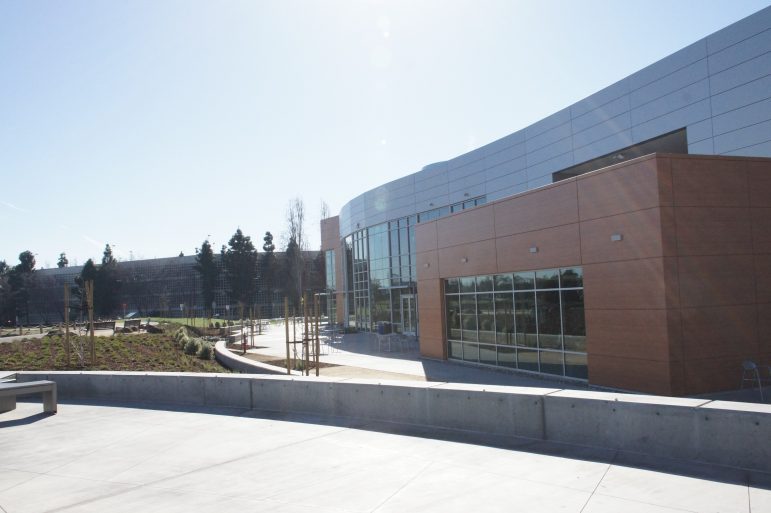SONY DSC

Design Tech High School’s new campus on the Oracle Headquarters opened in early January to kick off the semester.
D.tech is a charter school in the San Mateo Union High School District founded in 2014. Charter schools receive public funding, but are independently run. The school was founded on the principles of design thinking, a problem-solving method used at Stanford’s Institute of Design.
The campus cost Oracle $43 million to build, reported the New York Times. D.tech is paying Oracle $1 in rent each year.
D.tech students, parents, staff and architects have been working on the building’s design since the founding class’ freshman year.
The planning for the campus first started out as “design challenges” for the whole school.
“We used design thinking methods and asked, ‘What kind of spaces do we need?’” said senior Julia Wang.
This thought process led to the school having numerous “breakout rooms” for students to study in or use during class. Additionally, the halls are filled with tables, chairs and beanbags for students to use during FIT, or focused independent time, which is essentially study hall.
Senior Whitney Wisnom was on a smaller design team with nine other students. Her group focused on designing the school as a whole.
“The architects really listened to the students, parents and staff,” she said. “There were so many voices. It was like a dream team.”
While designing the school, Wisnom was able to pitch ideas to be considered for the final product.
“We wanted the second floor to be open,” Wisnom said. “We wanted a huge open room and a catwalk. We got to help with that, and that’s what it looks like now. It felt like the sky was the limit. The architecture firm was willing to build a lot for us.”
Another custom feature is the Design Realization Garage.
It is a workspace for students to create projects and where the robotics team works. The space has high-tech machines, like 3-D printers and laser cutters.
A theme throughout the building is glass. Many of the classrooms have windows, and the exterior of the building has glass walls.
“There are even windows into the private teacher offices,” Wisnom said.
The brightness is a change from d.tech’s former campus at a hangar in Millbrae. When d.tech was first founded, it was housed in a hallway at Mills. Bits of the school’s past at Mills are scattered around the new campus.
“I like the colored neighborhoods,” Wisnom said. “It is like the Mills hallway, where we literally took paint and colored the room orange.”
Neighborhoods are a way to organize the classrooms, and each has its own color.
However, Wisnom hopes that d.tech will be able to further personalize the campus in the future.
“I know they just finished the new building, but I wish they let us personalize it more,” she said. “The hangar was very unique, and we haven’t had the chance to do that yet.”
There are other issues which d.tech students hope to fix.
“There is not a lot of space to eat lunch,” Wang said. “People just sit in the hallways.”
Additionally, students who drive to school have difficulties parking. Students are not permitted to park on the Oracle campus or in San Mateo and Redwood City residential areas, per d.tech’s contract with Oracle.
Students park in Foster City or Belmont and walk 15 to 20 minutes to school, Wang said. Some park in lots for libraries and parks, which Wang is not sure is allowed.
D.tech offers shuttles to school, and students can take the train. However, not all students go to campus at the school’s 8:40 a.m. start time because some take community college classes.
Although the New York Times reported that students are allowed to use Oracle’s gym, only the basketball and volleyball teams may use it for games.
“We don’t even get to use the Oracle gym for practices,” said freshman junior varsity basketball player Nikhil Godbole. “Only varsity gets to [regularly] use the gym for games. For JV, we only have three games in the gym.”
The school lacks many traditional high school sports features. Student athletes practice at facilities off campus.
“I think we need to add a soccer field or a football field,” Godbole said.
Freshman Ryan Ho also wishes the campus had a basketball court, but added, “We’re getting a Ping-Pong table, though.”
Furthermore, Director of Intersession Wendy Little wants a space where all the students could meet.
“It doesn’t have to be a traditional auditorium,” she said. “I didn’t realize how challenging it would be to get the whole school together at once.”
Although d.tech has significantly more space at Oracle than its previous campuses, it does not expect to expand.
“This [campus] was designed with our enrollment target, which was 550 students,” Little said. “So we won’t take more students. We don’t have capacity for that here.”
Additional reporting by Zack Cherkas
